Résultats de la recherche pour "bundle OR raspberry OR pi OR 4 OR 2 OR gb OR raspberry OR pi OR 4 OR or OR 5 OR and OR pico OR e OR book"
-
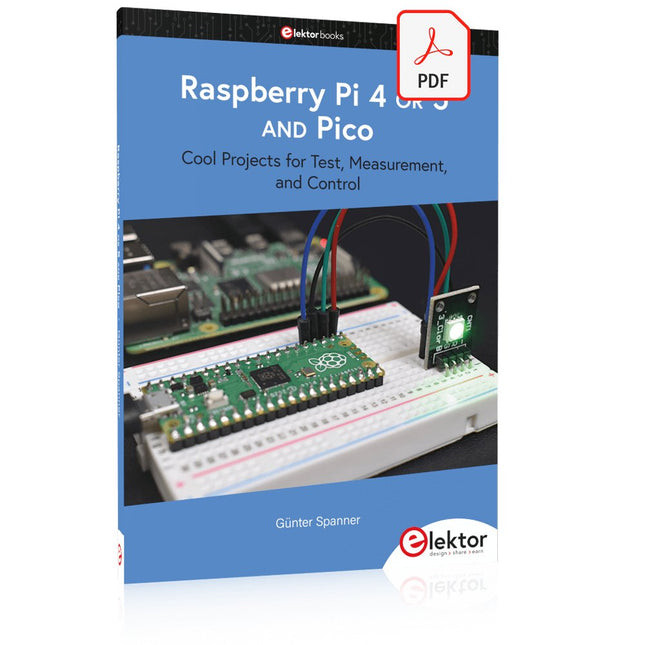
Elektor Digital Raspberry Pi 4 OR 5 AND Pico (E-book)
Cool Projects for Test, Measurement, and Control The Raspberry Pi has dominated the maker scene for many years. Freely accessible I/O pins have made it one of the most popular processor boards of all time. However, the classic Raspberry Pi has no analog inputs. Direct measurement of analog values is therefore not possible. Consequently, photodiodes, NTCs, Hall sensors, etc. cannot be read directly. In addition, the pins are connected directly to the exposed contacts, i.e. without a driver or protection circuit. This can quickly destroy the central controller and thus the entire Raspberry Pi. These problems can be elegantly solved with the Pico. As a front-end, it can easily handle a wide range of measurement tasks. In addition, the Pico is much cheaper than a classic Raspberry Pi 4 or 5. If a faulty circuit leads to the destruction of the Pico, this is relatively easy to handle. This makes the combination of a classic Raspberry Pi 4 or 5 and the Pico an ideal pair. The book introduces the broad and highly topical field of modern controller technology using the combined force of a Raspberry Pi 4 or 5 and a Raspberry Pi Pico. In addition to a detailed introduction to the operation and functionality of the controller boards themselves, the book also focuses on data acquisition and processing with digital processors. Especially the combination of both systems offers a wide range of interesting possibilities. Some practical projects from the contents: USB between Raspberry Pi 4 or 5 and Pico I²C Communication and Pico as an I²C device Voltmeter and Computer Thermometer Pico W as a Web Server and WLAN Scanner Frequency Meters and Generators OLED Displays on Raspberry Pi 4 or 5 and Pico Energy Saving Monitor Which Astronauts are in Orbit? Mini Monitor for Current Bitcoin Exchange Rate
€ 32,95
Membres € 26,36
-
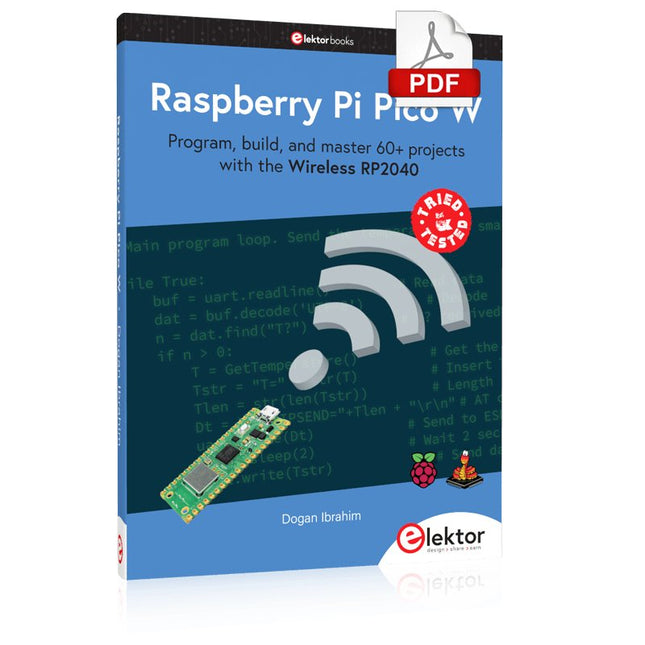
Elektor Digital Raspberry Pi Pico W (E-book)
Program, build, and master 60+ projects with the Wireless RP2040 The Raspberry Pi Pico and Pico W are based on the fast, efficient, and low-cost dual-core ARM Cortex M0+ RP2040 microcontroller chip running at up to 133 MHz and sporting 264 KB of SRAM and 2 MB of Flash memory. Besides spacious memory, the Pico and Pico W offer many GPIO pins, and popular peripheral interface modules like ADC, SPI, I²C, UART, PWM, timing modules, a hardware debug interface, and an internal temperature sensor. The Raspberry Pi Pico W additionally includes an on-board Infineon CYW43439 Bluetooth and Wi-Fi chipset. At the time of writing this book, the Bluetooth firmware was not yet available. Wi-Fi is however fully supported at 2.4 GHz using the 802.11b/g/n protocols. This book is an introduction to using the Raspberry Pi Pico W in conjunction with the MicroPython programming language. The Thonny development environment (IDE) is used in all of the 60+ working and tested projects covering the following topics: Installing the MicroPython on Raspberry Pi Pico using a Raspberry Pi or a PC Timer interrupts and external interrupts Analogue-to-digital converter (ADC) projects Using the internal temperature sensor and external sensor chips Using the internal temperature sensor and external temperature sensor chips Datalogging projects PWM, UART, I²C, and SPI projects Using Bluetooth, WiFi, and apps to communicate with smartphones Digital-to-analogue converter (DAC) projects All projects are tried & tested. They can be implemented on both the Raspberry Pi Pico and Raspberry Pi Pico W, although the Wi-Fi-based subjects will run on the Pico W only. Basic programming and electronics experience are required to follow the projects. Brief descriptions, block diagrams, detailed circuit diagrams, and full MicroPython program listings are given for all projects.
€ 34,95
Membres € 27,96
-
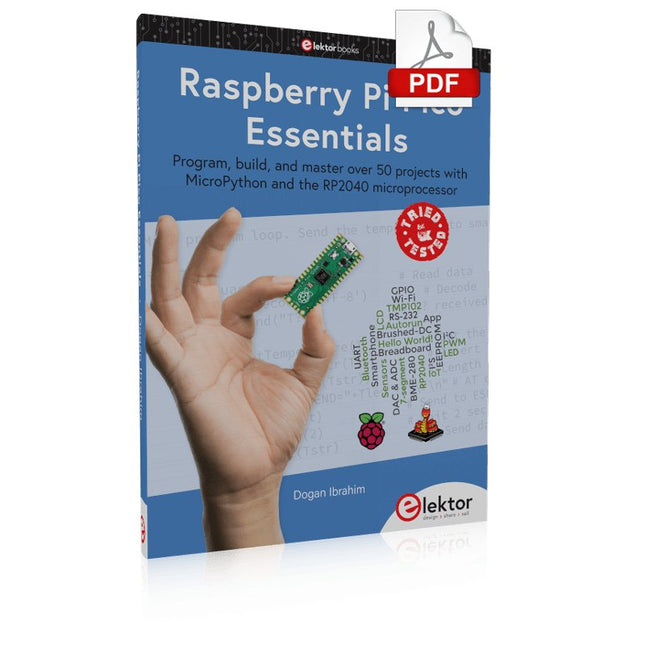
Elektor Digital Raspberry Pi Pico Essentials (E-book)
Le Raspberry Pi Pico est un microcontrôleur de haute performance conçu spécialement pour l'informatique physique. N'ayant pas de système d'exploitation, les microcontrôleurs diffèrent des ordinateurs monocartes, comme le Raspberry Pi 4. Le Raspberry Pi Pico peut être programmé pour exécuter efficacement une seule tâche dans des applications de contrôle et de surveillance en temps réel nécessitant de la rapidité. Le 'Pico', comme on l'appelle, est basé sur le microcontrôleur ARM Cortex-M0+ RP2040 à double cœur, rapide, efficace et peu coûteux, fonctionnant jusqu'à 133 MHz et disposant de 264 Ko de SRAM et de 2 Mo de mémoire Flash. Outre sa grande mémoire, le Pico présente des caractéristiques encore plus attrayantes, notamment un grand nombre de broches GPIO et des modules d'interface populaires comme ADC, SPI, I²C, UART et PWM. Pour couronner le tout, il offre des modules de synchronisation rapides et précis, une interface de débogage matériel et un capteur de température interne.Le Raspberry Pi Pico se programme facilement à l'aide des langages de haut niveau les plus courants, tels que MicroPython ou C/C++. Ce livre est une introduction à l'utilisation du microcontrôleur Raspberry Pi Pico avec le langage de programmation MicroPython. L'environnement de développement (IDE) Thonny est utilisé dans tous les projets décrits. Le livre contient plus de 50 projets testés et fonctionnels couvrant les sujets suivants:Installation de MicroPython sur Raspberry Pi Pico à l'aide d'un Raspberry Pi ou d'un PCLes interruptions du Timer et les interruptions externesDes projets sur convertisseur analogique-numérique Utilisation du capteur de température interne et du capteur de température externeDes projets d'enregistrement de donnéesDes projets de PWM, UART, I²C, et SPI Utilisation du Wi-Fi et des applications pour communiquer avec les smartphonesUtilisation de Bluetooth et d'applications pour communiquer avec les smartphonesDes projets sur convertisseur numérique-analogiqueTous les projets présentés dans ce livre sont fonctionnels et ont été entièrement testés. Des connaissances de base en programmation et en électronique sont nécessaires pour suivre les projets. De brèves descriptions, des schémas fonctionnels, des schémas de circuits détaillés et des listings complets des programmes MicroPython sont fournis pour tous les projets décrits. Les lecteurs peuvent trouver les listings des programmes sur la page Web Elektor créée à l'appui de ce livre.
€ 32,95
Membres € 26,36
-
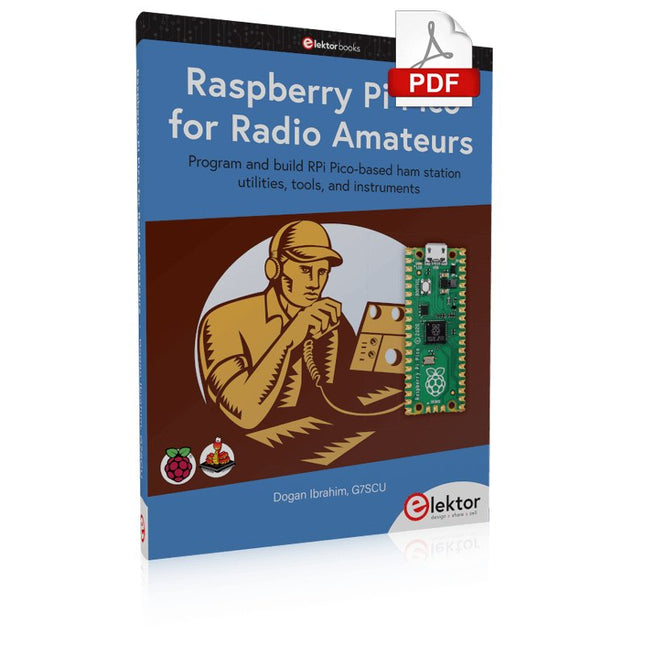
Elektor Digital Raspberry Pi Pico for Radio Amateurs (E-book)
Program and build RPi Pico-based ham station utilities, tools, and instruments Although much classical HF and mobile equipment is still in use by large numbers of amateurs, the use of computers and digital techniques has now become very popular among amateur radio operators. Nowadays, anyone can purchase a €5 Raspberry Pi Pico microcontroller board and develop many amateur radio projects using the “Pico” and some external components. This book is aimed at amateur radio enthusiasts, Electronic Engineering students, and anyone interested in learning to use the Raspberry Pi Pico to shape their electronic projects. The book is suitable for beginners in electronics as well as for those with wide experience. Step-by-step installation of the MicroPython programming environment is described. Some knowledge of the Python programming language is helpful to be able to comprehend and modify the projects given in the book. The book introduces the Raspberry Pi Pico and gives examples of many general-purpose, software-only projects that familiarize the reader with the Python programming language. In addition to the software-only projects tailored to the amateur radio operator, Chapter 6 in particular presents over 36 hardware-based projects for “hams”, including: Station mains power on/off control Radio station clock GPS based station geographical coordinates Radio station temperature and humidity Various waveform generation methods using software and hardware (DDS) Frequency counter Voltmeter / ammeter / ohmmeter / capacitance meter RF meter and RF attenuators Morse code exercisers RadioStation Click board Raspberry Pi Pico based FM radio Using Bluetooth and Wi-Fi with Raspberry Pi Pico Radio station security with RFID Audio amplifier module with rotary encoder volume control Morse decoder Using the FS1000A TX-RX modules to communicate with Arduino
€ 32,95
Membres € 26,36
-
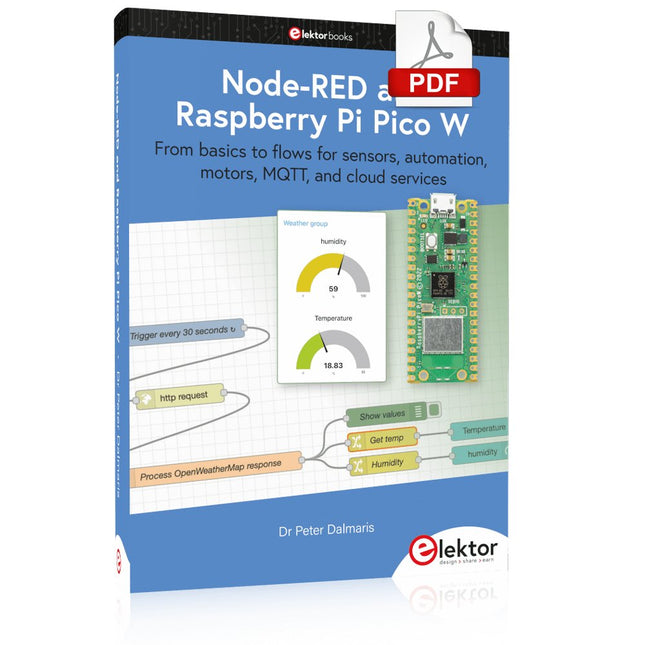
Elektor Digital Node-RED and Raspberry Pi Pico W (E-book)
From basics to flows for sensors, automation, motors, MQTT, and cloud services This book is a learning guide and a reference. Use it to learn Node-RED, Raspberry Pi Pico W, and MicroPython, and add these state-of-the-art tools to your technology toolkit. It will introduce you to virtual machines, Docker, and MySQL in support of IoT projects based on Node-RED and the Raspberry Pi Pico W. This book combines several elements into a platform that powers the development of modern Internet of Things applications. These elements are a flow-based server, a WiFi-enabled microcontroller, a high-level programming language, and a deployment technology. Combining these elements gives you the tools you need to create automation systems at any scale. From home automation to industrial automation, this book will help you get started. Node-RED is an open-source flow-based development tool that makes it easy to wire together devices, APIs, and online services. Drag and drop nodes to create a flowchart that turns on your lights at sunset or sends you an email when a sensor detects movement. Raspberry Pi Pico W is a version of the Raspberry Pi Pico with added 802.11n Wi-Fi capability. It is an ideal device for physical computing tasks and an excellent match to the Node-RED. Quick book facts Project-based learning approach. Assumes no prior knowledge of flow-based programming tools. Learn to use essential infrastructure tools in your projects, such as virtual machines, Docker, MySQL and useful web APIs such as Google Sheets and OpenWeatherMap. Dozens of mini-projects supported by photographs, wiring schematics, and source code. Get these from the book GitHub repository. Step-by-step instructions on everything. All experiments are based on the Raspberry Pi Pico W. A Wi-Fi network is required for all projects. Hardware (including the Raspberry Pi Pico W) is available as a kit. Downloads GitHub
€ 39,95
Membres € 31,96
-
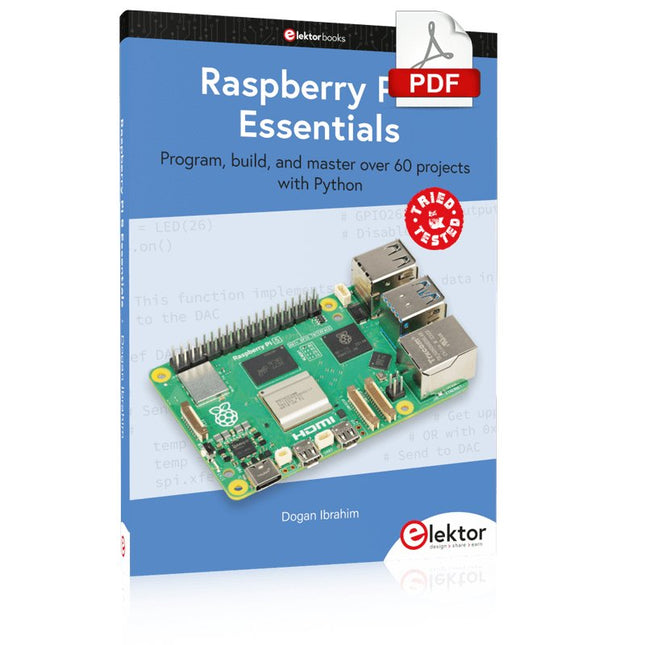
Elektor Digital Raspberry Pi 5 Essentials (E-book)
Program, build, and master over 60 projects with Python The Raspberry Pi 5 is the latest single-board computer from the Raspberry Pi Foundation. It can be used in many applications, such as in audio and video media centers, as a desktop computer, in industrial controllers, robotics, and in many domestic and commercial applications. In addition to the well-established features found in other Raspberry Pi computers, the Raspberry Pi 5 offers Wi-Fi and Bluetooth (classic and BLE), which makes it a perfect match for IoT as well as in remote and Internet-based control and monitoring applications. It is now possible to develop many real-time projects such as audio digital signal processing, real-time digital filtering, real-time digital control and monitoring, and many other real-time operations using this tiny powerhouse. The book starts with an introduction to the Raspberry Pi 5 computer and covers the important topics of accessing the computer locally and remotely. Use of the console language commands as well as accessing and using the desktop GUI are described with working examples. The remaining parts of the book cover many Raspberry Pi 5-based hardware projects using components and devices such as LEDs and buzzers LCDs Ultrasonic sensors Temperature and atmospheric pressure sensors The Sense HAT Camera modules Example projects are given using Wi-Fi and Bluetooth modules to send and receive data from smartphones and PCs, and sending real-time temperature and atmospheric pressure data to the cloud. All projects given in the book have been fully tested for correct operation. Only basic programming and electronics experience are required to follow the projects. Brief descriptions, block diagrams, detailed circuit diagrams, and full Python program listings are given for all projects described.
€ 32,95
Membres € 26,36
-
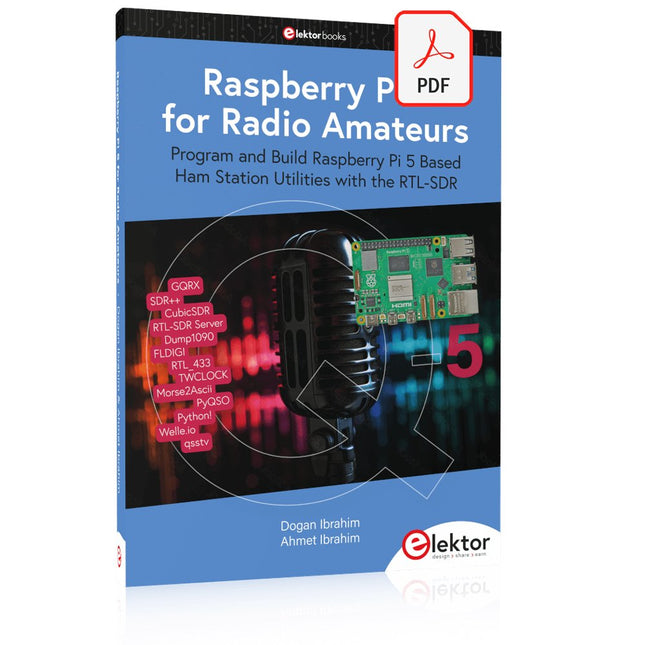
Elektor Digital Raspberry Pi 5 for Radio Amateurs (E-book)
Program and Build Raspberry Pi 5 Based Ham Station Utilities with the RTL-SDR The RTL-SDR devices (V3 and V4) have gained popularity among radio amateurs because of their very low cost and rich features. A basic system may consist of a USB based RTL-SDR device (dongle) with a suitable antenna, a Raspberry Pi 5 computer, a USB based external audio input-output adapter, and software installed on the Raspberry Pi 5 computer. With such a modest setup, it is possible to receive signals from around 24 MHz to over 1.7 GHz. This book is aimed at amateur radio enthusiasts and electronic engineering students, as well as at anyone interested in learning to use the Raspberry Pi 5 to build electronic projects. The book is suitable for both beginners through experienced readers. Some knowledge of the Python programming language is required to understand and eventually modify the projects given in the book. A block diagram, a circuit diagram, and a complete Python program listing is given for each project, alongside a comprehensive description. The following popular RTL-SDR programs are discussed in detail, aided by step-by-step installation guides for practical use on a Raspberry Pi 5: SimpleFM GQRX SDR++ CubicSDR RTL-SDR Server Dump1090 FLDIGI Quick RTL_433 aldo xcwcp GPredict TWCLOCK CQRLOG klog Morse2Ascii PyQSO Welle.io Ham Clock CHIRP xastir qsstv flrig XyGrib FreeDV Qtel (EchoLink) XDX (DX-Cluster) WSJT-X The application of the Python programming language on the latest Raspberry Pi 5 platform precludes the use of the programs in the book from working on older versions of Raspberry Pi computers.
€ 32,95
Membres € 26,36
-
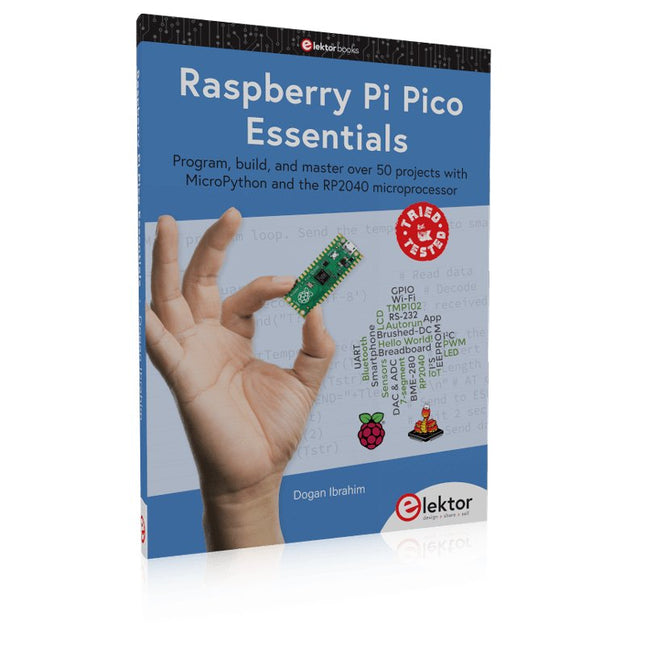
Elektor Publishing Raspberry Pi Pico Essentials
Le Raspberry Pi Pico est un microcontrôleur de haute performance conçu spécialement pour l'informatique physique. N'ayant pas de système d'exploitation, les microcontrôleurs diffèrent des ordinateurs monocartes, comme le Raspberry Pi 4. Le Raspberry Pi Pico peut être programmé pour exécuter efficacement une seule tâche dans des applications de contrôle et de surveillance en temps réel nécessitant de la rapidité. Le 'Pico', comme on l'appelle, est basé sur le microcontrôleur ARM Cortex-M0+ RP2040 à double cœur, rapide, efficace et peu coûteux, fonctionnant jusqu'à 133 MHz et disposant de 264 Ko de SRAM et de 2 Mo de mémoire Flash. Outre sa grande mémoire, le Pico présente des caractéristiques encore plus attrayantes, notamment un grand nombre de broches GPIO et des modules d'interface populaires comme ADC, SPI, I²C, UART et PWM. Pour couronner le tout, il offre des modules de synchronisation rapides et précis, une interface de débogage matériel et un capteur de température interne.Le Raspberry Pi Pico se programme facilement à l'aide des langages de haut niveau les plus courants, tels que MicroPython ou C/C++. Ce livre est une introduction à l'utilisation du microcontrôleur Raspberry Pi Pico avec le langage de programmation MicroPython. L'environnement de développement (IDE) Thonny est utilisé dans tous les projets décrits. Le livre contient plus de 50 projets testés et fonctionnels couvrant les sujets suivants:Installation de MicroPython sur Raspberry Pi Pico à l'aide d'un Raspberry Pi ou d'un PCLes interruptions du Timer et les interruptions externesDes projets sur convertisseur analogique-numérique Utilisation du capteur de température interne et du capteur de température externeDes projets d'enregistrement de donnéesDes projets de PWM, UART, I²C, et SPI Utilisation du Wi-Fi et des applications pour communiquer avec les smartphonesUtilisation de Bluetooth et d'applications pour communiquer avec les smartphonesDes projets sur convertisseur numérique-analogiqueTous les projets présentés dans ce livre sont fonctionnels et ont été entièrement testés. Des connaissances de base en programmation et en électronique sont nécessaires pour suivre les projets. De brèves descriptions, des schémas fonctionnels, des schémas de circuits détaillés et des listings complets des programmes MicroPython sont fournis pour tous les projets décrits. Les lecteurs peuvent trouver les listings des programmes sur la page Web Elektor créée à l'appui de ce livre.
€ 39,95
Membres € 35,96
-
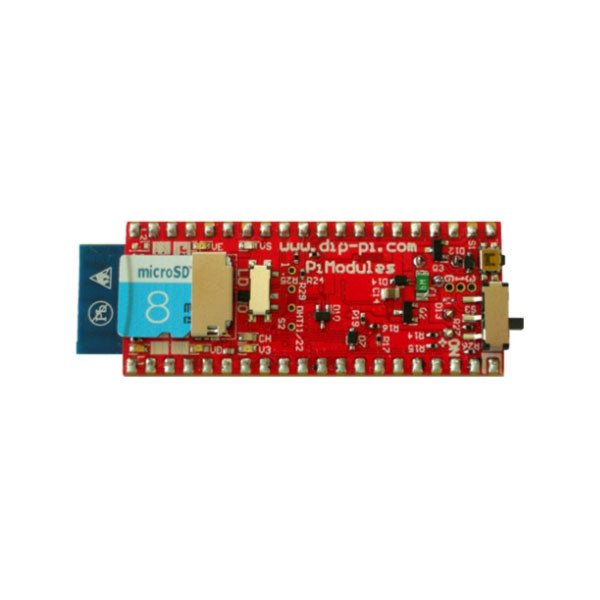
Pi Modules DiP-Pi Pico PIoT pour Raspberry Pi Pico
Le DiP-Pi PIoT est un système de connectivité WiFi avancé avec des interfaces intégrées de capteurs qui couvrent la plupart des besoins possibles pour les applications IoT basées sur Raspberry Pi Pico. Il peut fournir au système jusqu'à 1,5 A à 4,8 V délivrés de 6 à 18 V CC sur divers schémas d'alimentation comme les voitures, les installations industrielles, etc., en plus du micro-USB d'origine du Raspberry Pi Pico. Il prend en charge la batterie LiPo ou Li-Ion avec chargeur automatique ainsi que la commutation automatique de l'alimentation par câble à l'alimentation par batterie ou inversement (fonctionnalité UPS) en cas de perte d'alimentation par câble. La source d'alimentation étendue (EPR) est protégée par un fusible réinitialisable PPTC, à polarité inversée, ainsi que par ESD. Le DiP-Pi PIoT contient un bouton RESET intégré au Raspberry Pi Pico ainsi qu'un interrupteur coulissant ON/OFF qui agit sur toutes les sources d'alimentation (USB, EPR ou batterie). L'utilisateur peut surveiller (via les broches A/D du Raspberry Pi Pico) le niveau de la batterie et le niveau EPR avec les convertisseurs A/D de PICO. Les deux entrées A/D sont pontées avec des résistances 0402 (0 OHM), donc si pour une raison quelconque l'utilisateur a besoin d'utiliser ces broches Pico pour sa propre application, elles peuvent être facilement retirées. Le chargeur charge automatiquement la batterie connectée (si utilisée), mais l'utilisateur peut en outre allumer/éteindre le chargeur si son application en a besoin. DiP-Pi PIoT peut être utilisé pour les systèmes IoT alimentés par câble, mais également pour les systèmes purement alimentés par batterie avec ON/OFF. L'état de chaque source d'alimentation est indiqué par des LED informatives distinctes (VBUS, VSYS, VEPR, CHGR, V3V3). L'utilisateur peut utiliser n'importe quelle capacité de type LiPo ou Li-Ion ; Cependant, il faut veiller à utiliser des batteries protégées par PCB avec un courant de décharge maximum autorisé de 2 A. Le chargeur de batterie intégré est configuré pour charger la batterie avec un courant de 240 mA. Ce courant est réglé par une résistance, donc si l'utilisateur a besoin de plus/moins, il peut le changer lui-même. Le DiP-Pi PIoT est également équipé du module WiFi ESP8266 Clone avec antenne intégrée. Cette fonctionnalité ouvre une large gamme d'applications IoT basées sur celle-ci. En plus de toutes les fonctionnalités ci-dessus, le DiP-Pi PIoT est équipé de capteurs DHT11/22 à 1 fil intégrés et d'interfaces de carte micro-SD. La combinaison des interfaces étendues d'alimentation, de batterie et de capteurs rend le DiP-Pi PIoT idéal pour les applications IoT telles que l'enregistreur de données, la surveillance des usines, la surveillance des réfrigérateurs, etc. DiP-Pi PIoT est pris en charge avec de nombreux exemples prêts à l'emploi écrits en Micro Python ou C/C++. Caractéristiques Général Dimensions 21 x 51 mm Compatible avec le brochage Raspberry Pi Pico LED informatives indépendantes (VBUS, VSYS, VEPR, CHGR, V3V3) Bouton RESET du Raspberry Pi Pico Interrupteur à glissière ON/OFF agissant sur toutes les sources d'alimentation (USB, EPR, Batterie) Alimentation externe 6-18 VDC (voitures, applications industrielles, etc.) Surveillance du niveau d'alimentation externe (6-18 VCC) Surveillance du niveau de batterie Protection contre l'inversion de polarité Protection par fusible PPTC Protection ESD Chargeur de batterie automatique (pour LiPo, Li-Ion protégé par PCB – 2 A Max) Automatique/Contrôle utilisateur Passage automatique de l'alimentation par câble à l'alimentation par batterie et inversement (fonctionnalité UPS) Différents schémas d'alimentation peuvent être utilisés simultanément avec l'alimentation USB, l'alimentation externe et l'alimentation par batterie. Convertisseur Buck 1,5 A à 4,8 V sur EPR LDO intégré de 3,3 V à 600 mA Connectivité WiFi clone ESP8266 Commutateur de téléchargement du micrologiciel ESP8266 Interface 1 fil intégrée Interface DHT-11/22 intégrée Options d'alimentation Raspberry Pi Pico micro USB (via VBUS) Alimentation externe 6-18 V (via prise dédiée – 3,4/1,3 mm) Batterie externe Types de batteries pris en charge LiPo avec PCB de protection courant max 2A Li-Ion avec PCB de protection courant max 2A Périphériques et interfaces intégrés Interface 1 fil intégrée Interface DHT-11/22 intégrée Prise pour carte Micro SD Interface de programmation Raspberry Pi standard Pico C/C++ Raspberry Pi standard Pico Micro Python Compatibilité des cas Boîtier DiP-Pi Plexi-Cut Surveillance du système Niveau de batterie via Raspberry Pi Pico ADC0 (GP26) Niveau EPR via Raspberry Pi Pico ADC1 (GP27) LED informatives VB (VUSB) États-Unis (VSYS) VE (VEPR) CH (VCHR) V3 (V3V3) Protection du système Bouton de réinitialisation matérielle instantanée Raspberry Pi Pico Protection ESD sur EPR Protection contre l'inversion de polarité sur l'EPR Fusible PPTC 500 mA @ 18 V sur EPR Protection contre la surchauffe EPR/LDO EPR/LDO À propos de la protection actuelle Conception du système Conçu et simulé avec PDA Analyzer avec l'un des outils CAO/FAO les plus avancés – Altium Designer Origine industrielle Construction de circuits imprimés PCB de 2 oz en cuivre fabriqué pour une alimentation et un refroidissement appropriés en courant élevé Technologie de piste de 6 mils/écart de 6 mils PCB à 2 couches Finition de surface de PCB – Immersion Gold Tuyaux thermiques en cuivre multicouche pour une réponse thermique accrue du système et un meilleur refroidissement passif Téléchargements Fiche de données Manuel
€ 21,95€ 10,95
Membres identique
-
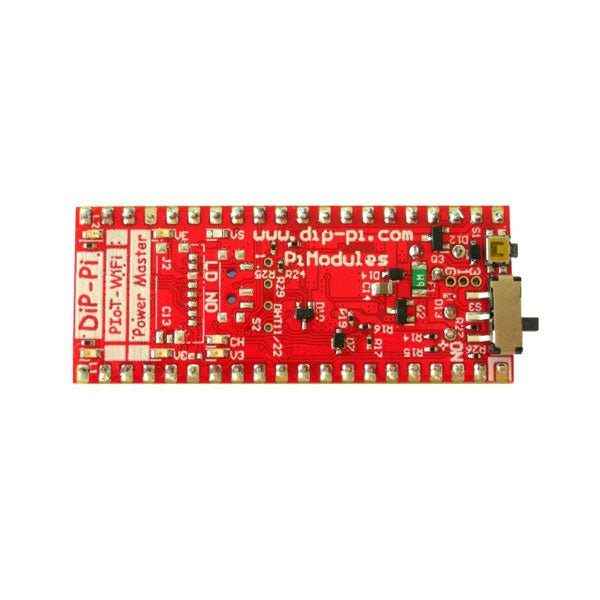
Pi Modules DiP-Pi Pico Power Master pour Raspberry Pi Pico
Le DiP-Pi Power Master est un système d'alimentation avancé avec des interfaces de capteurs intégrées qui couvrent la plupart des besoins possibles pour les applications basées sur Raspberry Pi Pico. Il peut fournir au système jusqu'à 1,5 A à 4,8 V délivrés de 6 à 18 V CC sur divers schémas d'alimentation comme les voitures, les installations industrielles, etc., en plus du micro-USB d'origine du Raspberry Pi Pico. Il prend en charge la batterie LiPo ou Li-Ion avec chargeur automatique ainsi que la commutation automatique de l'alimentation par câble à l'alimentation par batterie ou inversement (fonctionnalité UPS) en cas de perte d'alimentation par câble. La source d'alimentation étendue (EPR) est protégée par un fusible réinitialisable PPTC, à polarité inversée, ainsi que par ESD. Le DiP-Pi Power Master contient un bouton RESET intégré au Raspberry Pi Pico ainsi qu'un interrupteur coulissant ON/OFF qui agit sur toutes les sources d'alimentation (USB, EPR ou batterie). L'utilisateur peut surveiller (via les broches A/D du Raspberry Pi Pico) le niveau de la batterie et le niveau EPR avec les convertisseurs A/D de PICO. Les deux entrées A/D sont pontées avec des résistances 0402 (0 OHM), donc si pour une raison quelconque l'utilisateur a besoin d'utiliser ces broches Pico pour sa propre application, elles peuvent être facilement retirées. Le chargeur charge automatiquement la batterie connectée (si utilisée), mais l'utilisateur peut en outre allumer/éteindre le chargeur si son application en a besoin. DiP-Pi Power Master peut être utilisé pour les systèmes alimentés par câble, mais également pour les systèmes purement alimentés par batterie avec ON/OFF. L'état de chaque source d'alimentation est indiqué par des LED informatives distinctes (VBUS, VSYS, VEPR, CHGR, V3V3). L'utilisateur peut utiliser n'importe quelle capacité de type LiPo ou Li-Ion ; Cependant, il faut veiller à utiliser des batteries protégées par PCB avec un courant de décharge maximum autorisé de 2 A. Le chargeur de batterie intégré est configuré pour charger la batterie avec un courant de 240 mA. Ce courant est réglé par une résistance, donc si l'utilisateur a besoin de plus/moins, il peut le changer lui-même. En plus de toutes les fonctionnalités ci-dessus, le DiP-Pi Power Master est équipé d'interfaces de capteurs 1 fil et DHT11/22 intégrées. La combinaison des interfaces étendues d'alimentation, de batterie et de capteurs rend le DiP-Pi Power Master idéal pour les applications telles que l'enregistreur de données, la surveillance des usines, la surveillance des réfrigérateurs, etc. DiP-Pi Power Master est pris en charge avec de nombreux exemples prêts à l'emploi écrits en Micro Python ou C/C++. Caractéristiques Général Dimensions 21 x 51 mm Compatible avec le brochage Raspberry Pi Pico LED informatives indépendantes (VBUS, VSYS, VEPR, CHGR, V3V3) Bouton RESET du Raspberry Pi Pico Interrupteur à glissière ON/OFF agissant sur toutes les sources d'alimentation (USB, EPR, Batterie) Alimentation externe 6-18 V DC (voitures, applications industrielles, etc.) Surveillance du niveau d'alimentation externe (6-18 VCC) Surveillance du niveau de batterie Protection contre l'inversion de polarité Protection par fusible PPTC Protection ESD Chargeur de batterie automatique (pour LiPo, Li-Ion protégé par PCB – 2 A Max) Automatique/Contrôle utilisateur Passage automatique de l'alimentation par câble à l'alimentation par batterie et inversement (fonctionnalité UPS) Différents schémas d'alimentation peuvent être utilisés simultanément avec l'alimentation USB, l'alimentation externe et l'alimentation par batterie. Convertisseur Buck 1,5 A à 4,8 V sur EPR LDO intégré de 3,3 V à 600 mA Interface 1 fil intégrée Interface DHT-11/22 intégrée Options d'alimentation Raspberry Pi Pico micro USB (via VBUS) Alimentation externe 6-18 V (via prise dédiée – 3,4/1,3 mm) Batterie externe Types de batteries pris en charge LiPo avec PCB de protection courant max 2A Li-Ion avec PCB de protection courant max 2A Périphériques et interfaces intégrés Interface 1 fil intégrée Interface DHT-11/22 intégrée Interface de programmation Raspberry Pi standard Pico C/C++ Raspberry Pi standard Pico Micro Python Compatibilité des cas Boîtier DiP-Pi Plexi-Cut Surveillance du système Niveau de batterie via Raspberry Pi Pico ADC0 (GP26) Niveau EPR via Raspberry Pi Pico ADC1 (GP27) LED informatives VB (VUSB) États-Unis (VSYS) VE (VEPR) CH (VCHR) V3 (V3V3) Protection du système Bouton de réinitialisation matérielle instantanée Raspberry Pi Pico Protection ESD sur EPR Protection contre l'inversion de polarité sur l'EPR Fusible PPTC 500 mA @ 18 V sur EPR Protection contre la surchauffe EPR/LDO EPR/LDO À propos de la protection actuelle Conception du système Conçu et simulé avec PDA Analyzer avec l'un des outils CAO/FAO les plus avancés – Altium Designer Origine industrielle Construction de circuits imprimés PCB de 2 oz en cuivre fabriqué pour une alimentation et un refroidissement appropriés en courant élevé Technologie de piste de 6 mils/écart de 6 mils PCB à 2 couches Finition de surface de PCB – Immersion Gold Tuyaux thermiques en cuivre multicouche pour une réponse thermique accrue du système et un meilleur refroidissement passif Téléchargements Fiche de données Fiche de données
€ 17,95€ 8,95
Membres identique
-
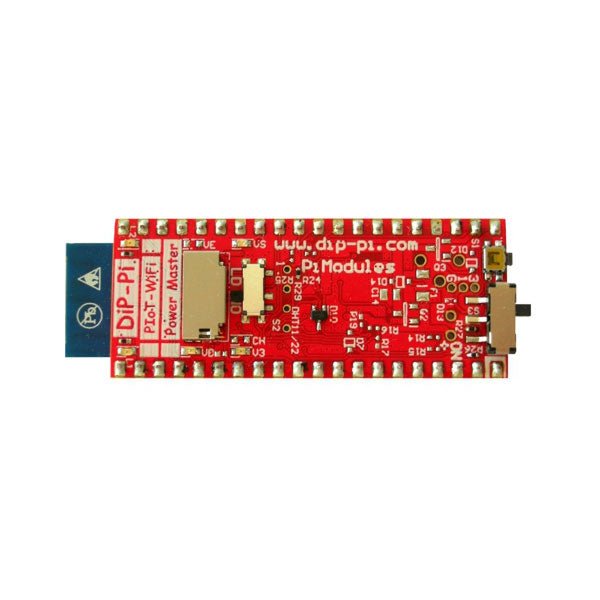
Pi Modules DiP-Pi Pico Maître WiFi pour Raspberry Pi Pico
Le DiP-Pi WiFi Master est un système de connectivité WiFi avancé avec des interfaces intégrées de capteurs qui couvrent la plupart des besoins possibles pour les applications IoT basées sur Raspberry Pi Pico. Il est alimenté directement depuis le Raspberry Pi Pico VBUS. Le DiP-Pi WiFi Master contient un bouton RESET intégré au Raspberry Pi Pico ainsi qu'un interrupteur à glissière ON/OFF qui agit sur les sources d'alimentation du Raspberry Pi Pico. Le DiP-Pi WiFi Master est équipé d'un module WiFi ESP8266 Clone avec antenne intégrée. Cette fonctionnalité ouvre une large gamme d'applications IoT basées sur celle-ci. En plus de toutes les fonctionnalités ci-dessus, le DiP-Pi WiFi Master est équipé de capteurs DHT11/22 à 1 fil intégrés et d'interfaces de carte micro-SD. La combinaison des interfaces étendues d'alimentation, de batterie et de capteurs rend le DiP-Pi WiFi Master idéal pour les applications IoT telles que l'enregistreur de données, la surveillance des usines, la surveillance des réfrigérateurs, etc. DiP-Pi WiFi Master est pris en charge avec de nombreux exemples prêts à l'emploi écrits en Micro Python ou C/C++. Caractéristiques Général Dimensions 21 x 51 mm Compatible avec le brochage Raspberry Pi Pico LED informatives indépendantes (VBUS, VSYS, V3V3) Bouton RESET du Raspberry Pi Pico Interrupteur à glissière ON/OFF agissant sur la source d'alimentation Raspberry Pi Pico LDO intégré de 3,3 V à 600 mA Connectivité WiFi clone ESP8266 Commutateur de téléchargement du micrologiciel ESP8266 Interface 1 fil intégrée Interface DHT-11/22 intégrée Options d'alimentation Raspberry Pi Pico micro USB (via VBUS) Périphériques et interfaces intégrés Interface 1 fil intégrée Interface DHT-11/22 intégrée Prise pour carte Micro SD Interface de programmation Raspberry Pi standard Pico C/C++ Raspberry Pi standard Pico Micro Python Compatibilité des cas Boîtier DiP-Pi Plexi-Cut LED informatives VB (VUSB) États-Unis (VSYS) V3 (V3V3) Protection du système Bouton de réinitialisation matérielle instantanée Raspberry Pi Pico Fusible PPTC 500 mA @ 18 V sur EPR Protection contre la surchauffe EPR/LDO EPR/LDO À propos de la protection actuelle Conception du système Conçu et simulé avec PDA Analyzer avec l'un des outils CAO/FAO les plus avancés – Altium Designer Origine industrielle Construction de circuits imprimés PCB de 2 oz en cuivre fabriqué pour une alimentation et un refroidissement appropriés en courant élevé Technologie de piste de 6 mils/écart de 6 mils PCB à 2 couches Finition de surface de PCB – Immersion Gold Tuyaux thermiques en cuivre multicouche pour une réponse thermique accrue du système et un meilleur refroidissement passif Téléchargements Fiche de données Manuel
€ 19,95€ 9,95
Membres identique
-
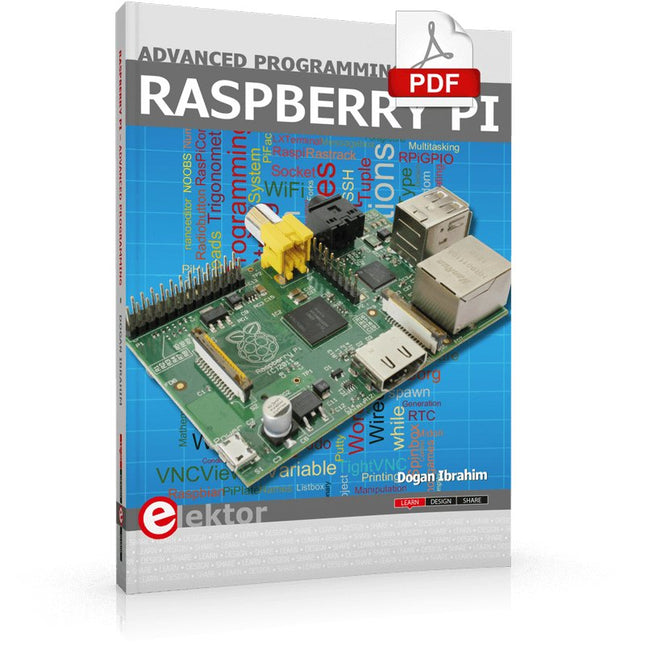
Elektor Digital Raspberry Pi Advanced Programming (E-book)
This book is about advanced programming of the Raspberry Pi computer using the Python programming language. The book explains in simple terms and with examples: How to configure the Raspberry Pi computer; How to install and use the Linux operating system and the desktop; How to write advanced programs using the Python programming language; How to use graphics in our programs; How to develop hardware based projects using the Raspberry Pi. The book starts with an introduction to the Raspberry Pi computer and covers the topics of purchasing all the necessary accessories and installing and operating the Linux operating system in command mode. The network interface of the RPi is explained in simple steps, demonstrating how the computer can be accessed remotely from a desktop or a laptop computer. The remaining parts of the book cover the Python programming language in detail, including advanced topics such as operating system calls, multitasking, interprocess synchronization and interprocess communication techniques. The important topic of network programming using UDP and TCP protocols is described with working examples. The Tkinter graphical user interface module (GUI) is described in detail with example widgets and programs. The last part of the book includes hardware projects based on using the advanced programming topics such as multitasking and interprocess communication techniques. All the projects given in the book have been fully tested and are working. Complete program listings of all projects are provided with detailed explanations.
€ 34,95
Membres € 27,96











